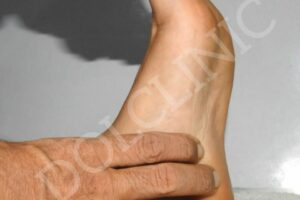Customized footwear – Diabetic/non-diabetic
Customized footwear – Diabetic/non-diabetic
This blog will tell you about diabetic shoes, customized shoes/footwear, offloading, different types of shoes, how they help and how they are prepared.
How customized footwear help prevent complications/amputations in diabetes and non-diabetics? What is special about diabetic shoes/ What are best diabetic shoes?
Good customized footwear is the gold standard and essentially distributes the pressure of our body evenly over the whole area of sole of the foot, thereby reducing high pressure points. This absorbs the shock, reduces pressure and helps in preventing ulcers, corns, foot pain and ankle pain. To understand this further we need to know why diabetics or others can get foot problems/pain. (A consultation with foot surgeon is advised)
Every person is borne with unique shape of feet. Also the shape of individual foot keeps changing with time, more so in diabetics. This affects the pressure distribution and high pressure areas. This is why some people get more pain when walking. Hence, it is essential that the insole of the shoe if specially made, distributes the pressure (offloading), reduces pressure areas, protects feet and avoids ulcers/infection/injury. The best way to do this is to make the assessment of the shape, the pressure, the curves and the angles of individual food and prepare a shoe just for that foot. This can be used only by that person and only for that foot.
Why diabetics get foot problems, foot ulcers, corns?
When we normally walk, the sole of the foot gets the pressure of the whole body. Usually the pressure is distributed over a large area.
But in diabetics there are high pressure areas which get the weight of whole body on a small area. Repeated walking on these areas starts damaging the skin there. This combined with lack of pain sensation (owing to a complication of diabetes called neuropathy) makes the condition worse, as the person is not aware of the damage happening. Sooner or later, this area of skin gives away and skin breaks down, forming an ulcer. So, really in diabetics, the ulcer starts from within, most of the time. This is the cause of ulcers in more than 80% of cases.
How customization of footwear can help non-diabetic foot pain?
Customized footwear (insole) is the best way to redistribute the pressure over whole foot, reduce pressure points, absorb shocks give arch support and correct the tilt/angulation. This can help many foot/ankle pains without surgery (A consultation with foot surgeon is advised)
Some people are borne with feet which are slightly off the normal structure, like high arch foot and flat foot. Some have weak ligaments and joints. This combined with the hard, flat and artificial surface we walk upon creates high pressure points and strain on the arches of the foot. Customizing footwear can relieve some of these problems.
What are other causes of Diabetic foot problems, ulcers?
Other reasons are poor blood supply, delicate skin, poor immunity, high blood sugar level , poor general health
Can amputations be prevented by footwear?
Research has shown that almost 85% of amputations in diabetics can be prevented by using diabetic footwear and other preventive foot care measures.
How socks help diabetes? Are socks necessary in diabetes?
Socks provide protection when we are not wearing shoes, add extra buffer, prevent unforeseen injuries, especially at home, bring down shearing force. It is advisable that diabetics wear at least simple cotton socks.
What are different types of shoes relevant to Diabetes or foot pain?
- Customized – By far the gold standard. The shape is recorded ideally manually by a skilled person using a mold or by scanning and insole prepared.
- Post-surgical – Can have front wedging or heel wedging
- Air cast shoes – air forms a cushion to hold the leg. Useful in ankle problems
- Sports shoes – When expertise is not available, a simple sports shoe, a size bigger than that of your foot is advisable, so that it serves at least these three purposes-
- Soft insole, absorbs shock, reduces pressure
- Covers and protects foot from all side,
- Broad in front, giving space to toes, avoids crowding
How are customized shoes made?
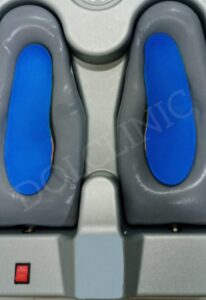
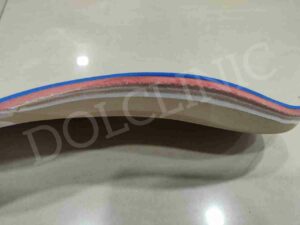
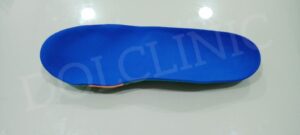
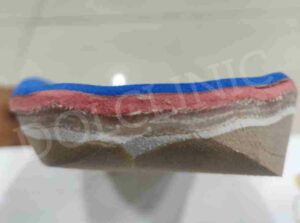
There are different methods. Broadly, they can be divided in two methods manual and computerized. By far manual is the best if assessment is done by an expert professional.
Manual – These are the basic steps involved (the way we do it)
- The diabetic foot professional will ask your problems (like pain, lack of sensation, and location of pain), examine foot for any problems like deformity, thick skin, ulcer, and weakness and if necessary ask for investigations. Usually a simple X-ray can be enough. But, if need arises, other methods of scanning can be used. For example, MRI helps checking infection spread; X-ray shows bone alignments, Doppler tell about foot circulation (venous and arterial), pressure scans tell about high pressure areas, etc. But, most will only need an X-ray.
- The professional will then assess the foot dynamics in static (standing) and in dynamic (walking) situation. Here the arches, the angulation, the tilt, etc. are noted. A video of feet while walking may be recorded.
- This is followed by a mold or a cast of foot.
- The mold is used to prepare the insole from different materials.
- You can either request shoes in addition or chose your own shoes and we will put the customized insole into it. Usually we advise the patient to get a shoe of their choice, 1 size bigger than their feet size.
Computerized – A computer makes pressure assessment. This can further be transferred to manual method of making or a computerized method of making. This is called CAD-CAM technology (CAD – Computerized aided design, CAM – Computerized aided manufacturing). Unless done under the supervision of an expert diabetic foot professional, it can be risky.
What do I do if customized diabetic shoes/footwear is not available?
Many places may not have an expertise in diabetic foot and customized footwear/shoes may not be available. Under the guidance of available professional, one may use sports shoes (non-branded will do). It should be a size bigger than that of your foot is advisable, so that it serves at least these three purposes –
- Soft insole, absorbs shock, reduces pressure.
- Covers and protects foot from all side.
- Broad in front, giving space to toes, avoids crowding.
How often diabetic shoes/footwear need to be changed? Once made, are the diabetic shoes/footwear forever?
Depending upon the material used, we advise to change insoles 6-12 monthly. The reason being, that not only the insole gets worn out, but also the shape and dynamics and pressure areas of foot change, requiring the alteration in insole. By far, this is a simple and inexpensive way to avoid any complication in foot.
Do all diabetics need special shoes?
Yes. For reasons mentioned above, diabetics are at a higher risk of foot problems. Once neuropathy sets in (which usually is loss of sensation, hence patient never complains), the risk increases manifold. When ulcer/infection occurs, treatment is risky, and expensive. So diabetic footwear/shoes and diabetic foot care is the best way to avoid any foot problems in diabetes. Research has shown that by these simple steps 85% foot problems and amputations can be avoided
Prevention is Better, Safer, Cheaper than treatment.
Read–

